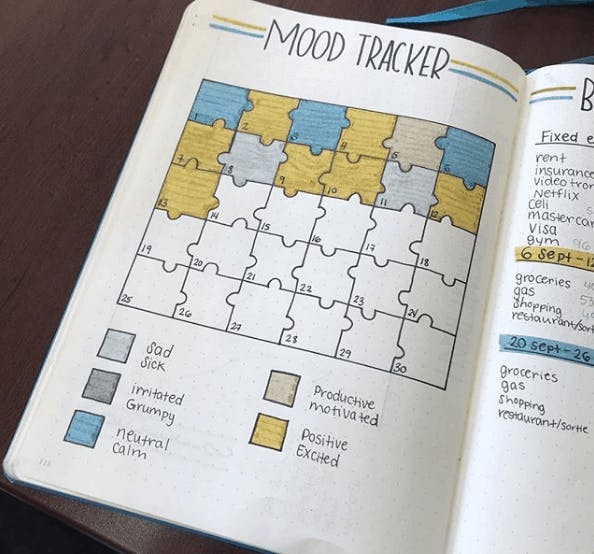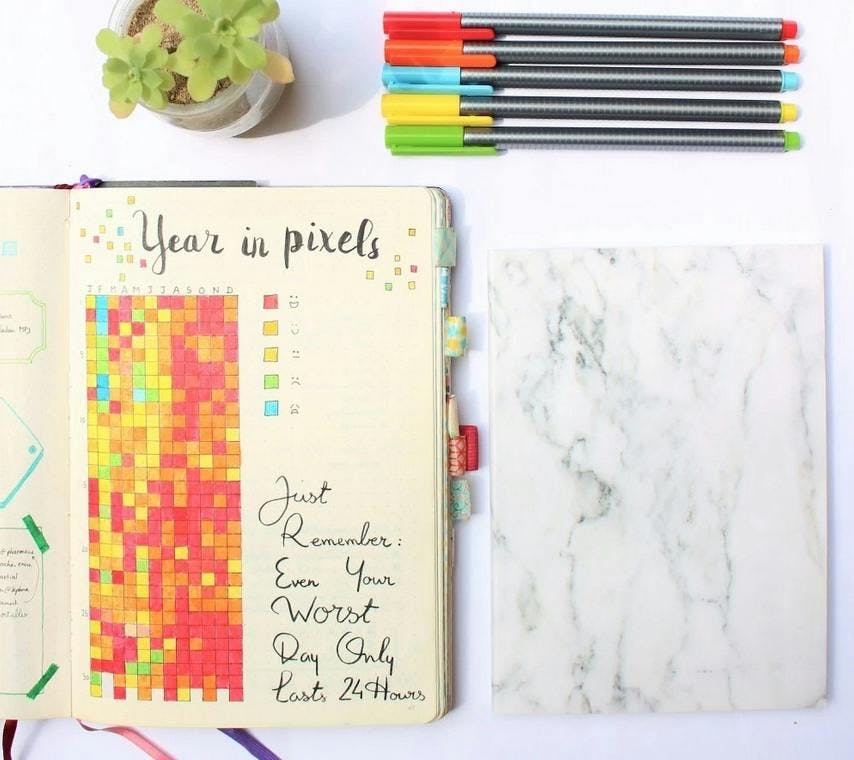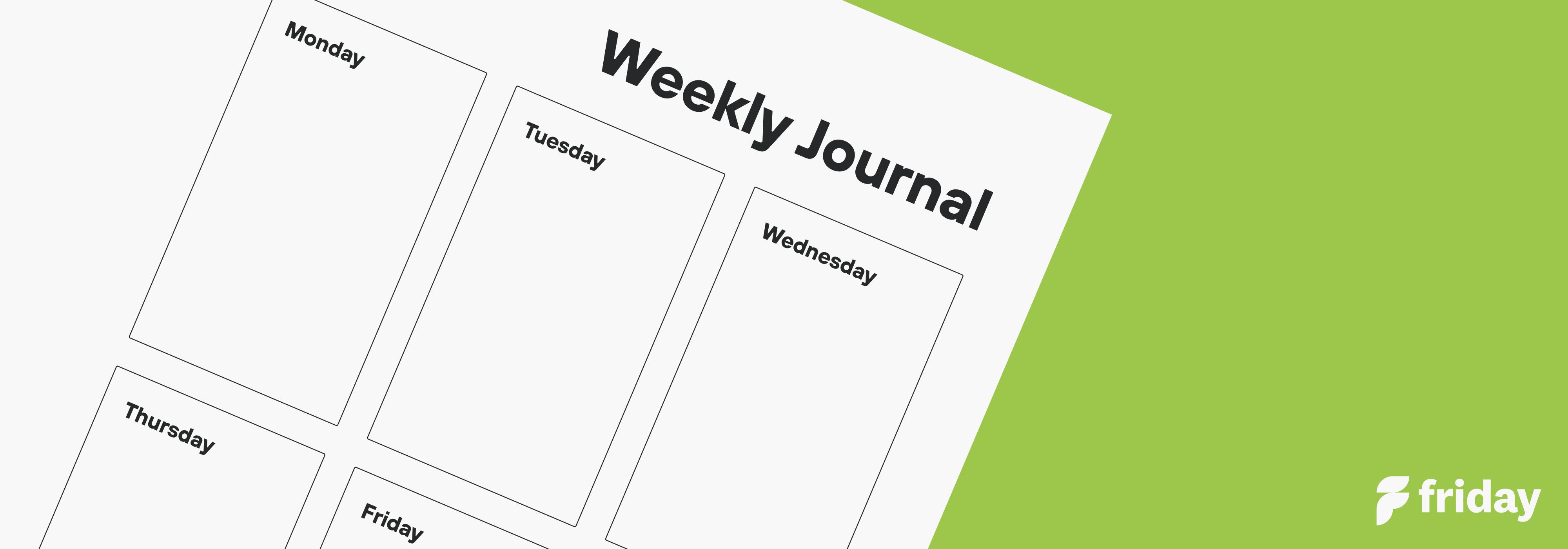How And Why You Should Use Bullet Journal Mood Trackers
One of the many feats we humans have tasked ourselves with is to translate the great muddle of sensory information we experience and turn it into something tangible and communicable.
“When asked about the specific character of greenness or the distinctive qualities of the many discernible shades of green,” says musicologist Jan L. Broeckx, “no exertion of the greatest verbal talent can compete with the simplest pictorial representation [and] the same applies to... the nature of sound.”
We try our best.
We have onomatopoeia: bang, crash, hiss, and thud.
We have color idioms: see red, feel blue, yellow-bellied.
Yet, it’s in vain. Time and time again, we find it impossible to fully express our senses.
Ready to start your digital bullet journal? Start on Friday -- for free!
It’s Tricky To Capture Our Emotions. But There Are Rewards.
Even though perfectly encapsulating your emotions is – to put it lightly – quite tricky, there are big rewards for those that still try, and not only to well-being and mental health.
Diaries and journals are the standard method of doing so, but with the rise of digital devices, mood tracker apps and micro-blogs are becoming more prevalent.
Since a bullet journal is a means to compile a lot of life into a few pages, it’s hard to include everything. After work, family, finances, appointments, birthdays and hobbies, one might forget to ask themselves how they feel.
However, with journal-keepers, app-users and researchers alike all reporting numerous positive effects, in both personal and professional capacities, not keeping track of your mood might be doing some damage.
What is a Bullet Journal Mood Tracker?
In a clinical sense, mood trackers are used for patients with mood disorders, depression, or anxiety. They often appear as cumbersome checklists of adjectives, but this doesn’t suit every-day life. One response to this problem is journal mood-tracking, inherently more efficient and creative.
Bullet journal mood trackers are a way to log mood patterns to infer sources of positive and negative impacts on your life.
In keeping with the BuJo style, the information is presented as clearly and effectively as possible, but there is opportunity to be inventive and build a personalized tracker around individual taste.
What Should Be Included in a Bullet Journal Mood Tracker?
Structurally, there are two main approaches to tracking mood: qualitative (words) and quantitative (numbers).
If you enjoy writing diaries, save space for a reflective passage in your daily or weekly spread . Conversely, if you enjoy charts and data, use the monthly spread, or create a dedicated mood page,
If you’re looking for some inspiration on mood tracking designs, here are a few bullet journal ideas with some great styles:
1. Color Grid
One simple mood tracker design is to create a grid, assign colors to your key and color a square on a daily basis. You can scale down the grid to fit into the monthly spread or create a dedicated mood page. Either way, you’ll be able to visually contrast the high and low points of the month.
The image below is from bulletjournaladdict.com.

2. Color Drawing
Bullet journaling never tries to constrain creativity, so if a grid style doesn’t suit you, sketch out any shape. You still follow the same color-key principle. At the end of the month, you’re left with a beautiful representation of your mood.
The image below is from sweetplanit.com.

3. Year in Pixels
If you plan on analyzing where the best parts of your year were, you can make a “year in pixels” page. You can use a colored key to represent adjectives or numerical scale. This design is a great review resource, allowing you to observe your behavior throughout a longer timeframe.
The image below is from bulletjournal.com.

4. Digital bullet journals
We all experience the convenience of digital, daily. Journaling and mood tracking can be made faster and less time-consuming by automated features. “Digital tools can improve the validity of any self-report,” claims Conduct Science, “digital mood journals, in particular, have numerous benefits.”
Digital platforms allow users to respond to personalized questions, or other unique prompts such as emoji-raters. Starting a productive day is made easier by establishing a recurring morning routine, scheduled for anytime. Furthermore, any data you enter will be periodically converted to reports and insights, so you can closely monitor trends and patterns in your behavior and mood.
The image below is from Friday, one of the leading digital bullet journals:

If you'd like to see how Friday works as a bullet journal app, feel free to watch the video below:
What are the Benefits of Tracking Mood?
Despite the particular design you choose, or whether you go digital or paper, there’s ample evidence to imply everyone should begin tracking their mood. Established research into clinical and general use of mood tracking practices consistently shows the potential benefits, but more recent studies suggest that mood tracking could have extended implications in the workplace, too.
1. Behavior affects Mood which affects Behavior
The most immediate benefit is that you are able to contrast positive and negative times in your life. Although this data alone has limited use, combining a mood tracker with other elements of your bullet journal allows you to connect any activity or behavior on a specific day to the subsequent mood, allowing you to infer the causes of stress and sources of happiness. From there, you’re more capable of adjusting behavior patterns to promote personal development and growth.
Current research suggests that “self-monitoring of a behavior adjusts the frequency of the behavior… If the behavior is seen as negative, the frequency is reduced, whereas the frequency of a more positive behavior would be increased.”
Tracking your mood is an active step towards self-awareness of negative behavior. Although humans are naturally great at pattern-recognition, we are often blind to our own downfalls; seeing a visualization of your mood, united with other BuJo tools like the Habit Tracker, can resolve our temporary ignorance.
2. Controlling Self and Environment
Researchers at the University of California analyzed 1,000 user reviews for mood-tracking apps and saw that many users had reported experiencing significant benefits. “By monitoring and learning about their own emotions, users reported feeling more in control of their mood, making informed decisions with the goal to become happier, and becoming more confident and positive in their emotional well-being.”
Much like how the mere act of setting goals has been proven to increase your commitment to them, most notably in a 2009 study, the process of tracking your mood increases your motivation to improve it. Frequent occurrences of negative mood will force you to ask questions about yourself and your environment, inspiring you to make the necessary changes to become happier and healthier.
3. Depression and Anxiety
Everyone should periodically ask themselves how they’re feeling, but those more prone to depression and anxiety can find further benefits to tracking their mood. A recent study in BMC Psychiatry found that, in nine separate studies, “mood monitoring was effective in improving depression score”
In South Africa, mood disorder patients partook in weekly mood-monitoring telephone consultations. In the concluding survey, “the majority (86.5%) [of participants] stated that the study had helped them and had a positive impact on their lives.”
Considering that data from thirty-nine countries suggests that roughly one in ten experience some form of mood disorder, the scope for journal and digital mood trackers to improve lives is broad.
4. Monday Blues, Friday Feeling
The relevance of tracking moods in a personal capacity has been studied extensively, but now researchers are looking at their application in the workplace. A 2017 study on mood and productivity at work, in which call center employees used mood-tracking apps, argues “self-tracking in a work setting [has] potential to improve work performance”, which concurs with “the existing literature [that] indicates self-tracking of mood can increase reflection about personal work behavior, which in turn influences collaborative work.”
While self-mood tracking can boost individual productivity, it has also been shown to strengthen the bonds between those working in a team. A 2013 study on the implications of professional micro-blogging (very short, regular blog entries) found that members of a remote team felt more connected to each other when able to share their moods and activities.
Furthermore, a 2012 study had colleagues track their mood throughout virtual meetings. Participants used an app that quantified their mood and energy from 0 to 1. Their scores were visible to other members. Participants believed that “the possibility of comparing the mood of oneself with the team’s mood was... the most obvious benefit [which] helps to develop the emotional intelligence of the team.”
It’s clear to see that remaining conscious of your mood at work can both enhance your personal work rate and motivation to effectively conduct collaborative work with other team members. One thought is that if digital journals are well-implemented in the workplace, with feedback and survey capabilities, the effects of mood tracking may be even more substantial than results shown in recent studies.
If you don’t bullet journal, it may feel unusual to closely track your feelings every day. Yet, even if you’ve had limited practice, it can soon come naturally. While many perceive mood as simply working in the background, and question our ability to proactively alter it, the mood tracking population has found that a colored square, an emoji or a simple “How Am I?” at the end of each day works wonders, whether you’re at home or work.
We will never have the ability to capture the purity of our senses and feelings in writing. Green is green. Though, the very act of trying it means we can still reap the rewards. We’re all expected to ask each other how we’re doing. Why not extend the courtesy to yourself with a mood tracker bullet journal?

